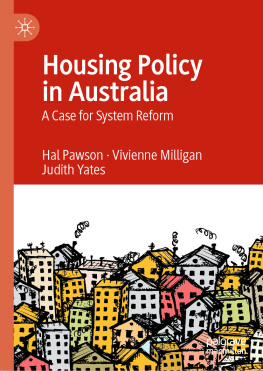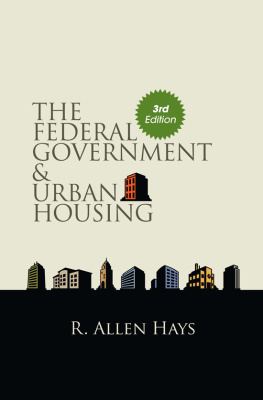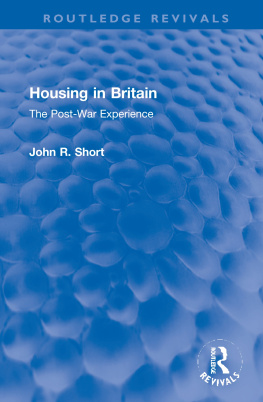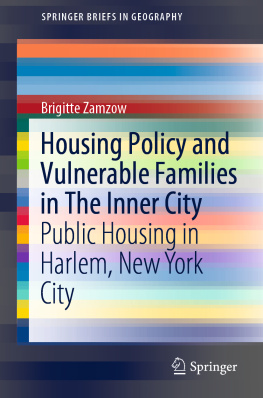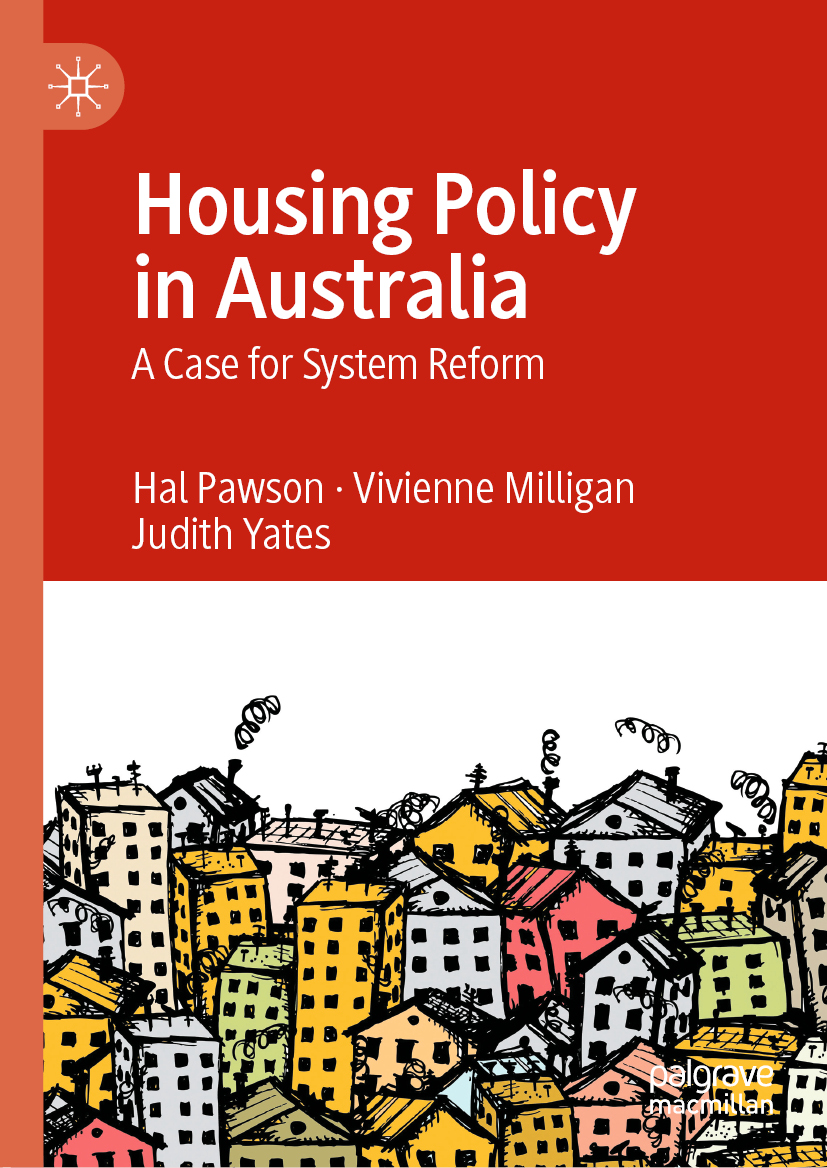Hal Pawson , Vivienne Milligan and Judith Yates
Housing Policy in Australia
A Case for System Reform
Hal Pawson
UNSW Sydney, Kensington, NSW, Australia
Vivienne Milligan
UNSW Sydney, Kensington, NSW, Australia
Judith Yates
University of Sydney, Sydney, NSW, Australia
ISBN 978-981-15-0779-3 e-ISBN 978-981-15-0780-9
https://doi.org/10.1007/978-981-15-0780-9
The Editor(s) (if applicable) and The Author(s), under exclusive license to Springer Nature Singapore Pte Ltd. 2020
This work is subject to copyright. All rights are solely and exclusively licensed by the Publisher, whether the whole or part of the material is concerned, specifically the rights of translation, reprinting, reuse of illustrations, recitation, broadcasting, reproduction on microfilms or in any other physical way, and transmission or information storage and retrieval, electronic adaptation, computer software, or by similar or dissimilar methodology now known or hereafter developed.
The use of general descriptive names, registered names, trademarks, service marks, etc. in this publication does not imply, even in the absence of a specific statement, that such names are exempt from the relevant protective laws and regulations and therefore free for general use.
The publisher, the authors and the editors are safe to assume that the advice and information in this book are believed to be true and accurate at the date of publication. Neither the publisher nor the authors or the editors give a warranty, expressed or implied, with respect to the material contained herein or for any errors or omissions that may have been made. The publisher remains neutral with regard to jurisdictional claims in published maps and institutional affiliations.
Cover illustration: www.gograph.com /[Kudryashka]
This Palgrave Macmillan imprint is published by the registered company Springer Nature Singapore Pte Ltd.
The registered company address is: 152 Beach Road, #21-01/04 Gateway East, Singapore 189721, Singapore
Australia has avoided a recession in its economic system for nigh on 30 years. Good management our political leaders claim. But Australias housing system has failed throughout this time: homelessness has risen; insecure and unaffordable rental are common-place; the over-valuing of homeownership has escalated; and a massive shortage of social and affordable housing has been allowed to develop. How is such neglect or mismanagement of Australians housing dreams possible? This book explains why and what to do about it.
Pawson, Milligan and Yates carefully document compelling evidence on these issues to provide a contemporary and robust analysis of the when, where, how and why of housing problems in Australia. Moreover, the authors provide the policy solutions and actions to be taken by Federal, State and local governments, as well as the development, finance and property management industries.
Pawson, Milligan and Yates are Australias foremost housing analysts. This book is essential reading for anyone with an interest or a care in reforming Australias housing system to be once again fit for all Australians.
Ian Winter,Housing consultant, and Director, Australian Housing and Urban Research Institute 200017
Housing policy and housing systems are rapidly changing and profoundly reshaping access to affordable and high quality housing across all Australias cities and regions. Housing Policy in Australia superbly harnesses international evidence and more than two decades of experience to not only analyse but also provide potential solutions to the current housing policy impasse. The books comprehensive canvassing of housing system diversitytenures, social differentiation, historical trendswill become necessary reading for housing practitioners and students. The ambitious reform agenda proposed by the book deserves to be carefully digested and implemented by professionals working across the housing sector.
Robyn Dowling,Professor of Planning and Dean of Architecture, Design and Planning, University of Sydney
Despite 27 years of uninterrupted economic growth, Australia confronts a crisis of structurally-embedded housing unaffordability and insecurity across all tenure types. Debt-fuelled speculative investment has driven high rates of after-housing poverty and declining access to home ownership, particularly for young Australians. The nations growing ranks of renters, most seriously those on low and moderate incomes, are trapped in a cycle of housing stress, at increasing risk of homelessness.
In this important book, three leading Australian scholars combine their respective and collective research and deep, industry-engaged policy expertise to explain how and why the bipartisan post-war commitment to secure, affordable housing as a fundamental platform for social and economic participation, has collapsed. They present a searing indictment of the very real and profound consequences of three lost decades of housing policy reform for all Australians, not only the most vulnerable.
Underpinned by a sophisticated analysis of the evolution and dynamics of housing policy, the institutions and systems in which it is embedded and with which it interacts, and informed by comparative analysis, this volume is an exemplar not only for housing and urban studies, but for policy studies more broadly.
The authors present an urgent and compelling case for a transformational national housing strategyincluding enhancements to the policy-making framework, phased reforms to alleviate the worst of current affordability pressures and coordinated, longer-term measures to tackle structural challenges. It is essential reading for policy-makers and those who advise them, including researchers, whose collective failures have created and sustained Australias housing policy vacuum. The book is accessible to all Australians concerned about future prosperity, social cohesion and wellbeing.
Anne Tiernan,Professor of Politics and Public Policy and Dean (Engagement), Griffith Business School, Griffith University, Australia
Foreword
For a country that has long considered itself to be relatively well housed, it may come as a surprise that Australia does not have a coherent housing policy, or at least not so youd notice. This is in marked contrast to the decades after World War Two when, in line with other comparable countries, the Federal government took up the challenge of housing Australians with gusto. The 1945 Commonwealth-State Housing Agreement heralded the advent of a generally comfortably housed population in the thirty years that followed. Housing became a prominent component of the now long-lost contract between what used to be called capital and labour with overt government support for housing being a fourth pillar of the post-war political settlement, alongside wages growth, social security and trade protection.
Fast forward to 2019 and a national policy framework for housing is just a faded memory. As the authors ofHousing Policy in Australianote, the last intellectual flowering of such an approach was the 19911992 National Housing Strategy, which at least attempted to conceive of housing as a holistic policy domain. Any hope that this might result in innovative policy reform quickly dissipated, however, and by the mid-1990s political interest in housing policy had collapsed. Hopes for positive reform were swept away by the neo-liberal turn in policymaking. Essentially this saw any direct involvement by government in housing dwindle to that of offering accommodation, on an increasingly temporary basis, to the most needy or homeless, or as a booster for the private market through increasingly generous taxation subsidies and permissive planning systems. In the process, housing has been tuned into a financialised and debt-fuelled speculative asset class in which prices have decoupled from household incomes. In effect, the market became the policy.

